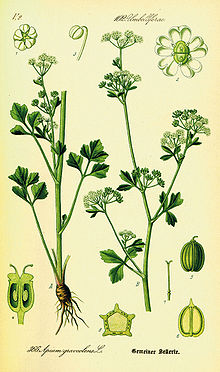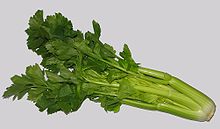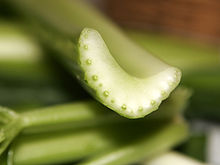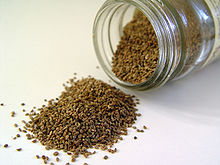- Celery
-
Celery 
Scientific classification Kingdom: Plantae (unranked): Angiosperms (unranked): Eudicots (unranked): Asterids Order: Apiales Family: Apiaceae Genus: Apium Species: A. graveolens Binomial name Apium graveolens
L.Apium graveolens is a plant species in the family Apiaceae commonly known as celery (var. dulce) or celeriac (var. rapaceum), depending on whether the petioles (stalks) or roots are eaten: celery refers to the former and celeriac to the latter. Apium graveolens grows to 1 m tall. The leaves are pinnate to bipinnate leaves with rhombic leaflets 3–6 cm long and 2–4 cm broad. The flowers are creamy-white, 2–3 mm diameter, produced in dense compound umbels. The seeds are broad ovoid to globose, 1.5–2 mm long and wide.
Contents
Etymology
First attested in English 1664, the word "celery" derives from the French céleri, in turn from Italian seleri, the plural of selero, which comes from Late Latin selinon,[1] the latinisation of the Greek σέλινον (selinon), "parsley".[2][3] The earliest attested form of the word is the Mycenaean Greek se-ri-no, written in Linear B syllabic script.[4] The Ancient Greek colony of Selinous (Greek: Σελινοῦς, Selinoūs), on Sicily, was named after wild parsley that grew abundantly there; Selinountian coins depicted a parsley leaf as the symbol of the city.
Taxonomy
Celery was described by Carl von Linné in Volume One of his Species Plantarum in 1753.[5]
The closely related Apium bermejoi from the island of Minorca is one of the rarest plants in Europe, with fewer than 100 individuals left.[6]
Cultivation
 Celery root, or celeriac, is also used as a vegetable.
Celery root, or celeriac, is also used as a vegetable.
In North America, commercial production of celery is dominated by the varieties called Pascal celery.[7] Gardeners can grow a range of cultivars, many of which differ little from the wild species, mainly in having stouter leaf stems. They are ranged under two classes, white and red; the white cultivars being generally the best flavoured, and the most crisp and tender. The stalks grow in tight, straight, parallel bunches, and are typically marketed fresh that way, without roots and just a little green leaf remaining.
The wild form of celery is known as "smallage". It has a furrowed stalk with wedge-shaped leaves, the whole plant having a coarse, earthy taste, and a distinctive smell. The stalks are not usually eaten (except in soups or stews in French cuisine), but the leaves may be used in salads, and its seeds are those sold as a spice.[8] With cultivation and blanching, the stalks lose their acidic qualities and assume the mild, sweetish, aromatic taste particular to celery as a salad plant.
The plants are raised from seed, sown either in a hot bed or in the open garden according to the season of the year, and after one or two thinnings and transplantings, they are, on attaining a height of 15–20 cm, planted out in deep trenches for convenience of blanching, which is effected by earthing up to exclude light from the stems.
In the past, celery was grown as a vegetable for winter and early spring; it was perceived as a cleansing tonic, welcomed to counter the salt-sickness of a winter diet. By the 19th century, the season for celery had been extended, to last from the beginning of September to late in April.[9]
Harvesting and storage
Harvesting occurs when the average size of celery in a field is marketable; due to extremely uniform crop growth, fields are harvested only once. The petioles and leaves are removed and harvested; celery is packed by size and quality (determined by colour, shape, straightness and thickness of petiole, stalk and midrib length and absence of disease, cracks, splits, insect damage and rot). Under optimal conditions, celery can be stored for up to seven weeks between 0 to 2 °C (32 to 36 °F). Inner stalks may continue growing if kept at temperatures above 0 °C (32 °F). Freshly cut petioles of celery are prone to decay, which can be prevented or reduced through the use of sharp blades during processing, gentle handling, and proper sanitation.[10]
Cut pieces of celery last only a few hours before they turn brown, and few American restaurants include it in green salads because it cannot be prepared far enough ahead of time. In the past, restaurants used to store it in a container of water with powdered vegetable preservative; however, the sulfites in the preservative caused allergic reactions in some people.[11] In 1986, the U.S. Food and Drug Administration banned the use of sulfites on fruits and vegetables intended to be eaten raw.[12]
Uses
Celery, raw Nutritional value per 100 g (3.5 oz) Energy 57 kJ (14 kcal) Carbohydrates 3 g - Sugars 1.4 g - Dietary fibre 1.6 g Fat 0.2 g Protein 0.7 g Water 95 g Vitamin C 3 mg (4%) Percentages are relative to US recommendations for adults.
Source: USDA Nutrient DatabaseApium graveolens is used around the world as a vegetable, either for the crisp petiole (leaf stalk) or the fleshy toproot.
In temperate countries, celery is also grown for its seeds. Actually very small fruit, these "seeds" yield a valuable volatile oil used in the perfume and pharmaceutical industries. They also contain an organic compound called apiol. Celery seeds can be used as flavouring or spice, either as whole seeds or ground and mixed with salt, as celery salt. Celery salt can also be made from an extract of the roots. Celery salt is used as a seasoning, in cocktails (notably to enhance the flavour of Bloody Mary cocktails), on the Chicago-style hot dog, and in Old Bay Seasoning.
Celery, onions, and bell peppers are the holy trinity of Louisiana Creole and Cajun cuisine. Celery, onions, and carrots make up the French mirepoix, often used as a base for sauces and soups. Celery is a staple in many soups, such as chicken noodle soup.
Medicine
The use of celery seed in pills for relieving pain was described by Aulus Cornelius Celsus around 30 AD.[13] Celery seeds contain a compound, 3-n-butylphthalide, that has been demonstrated to lower blood pressure in rats.[14]
It is thought to be an aphrodisiac by some people, because it is thought to contain androsterone, a metabolic product of testosterone. However, this is a misunderstanding of androstenone.[15][unreliable source?]
Bergapten in the seeds can increase photosensitivity, so the use of essential oil externally in bright sunshine should be avoided. The oil and large doses of seeds should be avoided during pregnancy, as they can act as a uterine stimulant. Seeds intended for cultivation are not suitable for eating as they are often treated with fungicides.
Nutrition
Celery is used in weight-loss diets, where it provides low-calorie dietary fibre bulk. Celery seeds are also a great source of calcium, and are regarded as a good alternative to animal products. However, contrary to popular belief, celery does not contain negative calories: digestion of celery does not burn more calories than a person obtains from it.[16]
100g of raw celery contains the following nutritional information according to the USDA:[17]
- Calories : 16
- Fat: 0.17
- Carbohydrates: 2.97
- Fibers: 2
- Protein: 0.69
- Cholesterol: 0
Allergies
Celery is among a small group of foods (headed by peanuts) that appear to provoke the most severe allergic reactions; for people with celery allergy, exposure can cause potentially fatal anaphylactic shock.[18] The allergen does not appear to be destroyed at cooking temperatures. Celery root—commonly eaten as celeriac, or put into drinks—is known to contain more allergen than the stalk. Seeds contain the highest levels of allergen content. Exercise-induced anaphylaxis may be exacerbated. An allergic reaction also may be triggered by eating foods that have been processed with machines that have previously processed celery, making avoiding such foods difficult. In contrast with peanut allergy being most prevalent in the US, celery allergy is most prevalent in Central Europe.[19] In the European Union, foods that contain or may contain celery, even in trace amounts, must be clearly marked as such.
History
Daniel Zohary and Maria Hopf[20] note that celery leaves and inflorescences were part of the garlands found in the tomb of pharaoh Tutankhamun (died 1323 BC), and celery mericarps dated to the seventh century BC were recovered in the Heraion of Samos. However, they note "since A. graveolens grows wild in these areas, it is hard to decide whether these remains represent wild or cultivated forms." Only by classical times is it certain that celery was cultivated.
M. Fragiska mentions an archeological find of celery dating to the 9th century BC, at Kastanas; however, the literary evidence for ancient Greece is far more abundant. In Homer's Iliad, the horses of the Myrmidons graze on wild celery that grows in the marshes of Troy, and in Odyssey, there is mention of the meadows of violet and wild celery surrounding the cave of Calypso.[21]
Cultural depictions
 Apium illustration from Barbarus Apuleius' Herbarium, circa 1400.
Apium illustration from Barbarus Apuleius' Herbarium, circa 1400.
A chthonian symbol among the ancient Greeks, celery was said to have sprouted from the blood of Kadmilos, father of the Cabeiri, chthonian divinities celebrated in Samothrace, Lemnos and Thebes. The spicy odour and dark leaf colour encouraged this association with the cult of death. In classical Greece, celery leaves were used as garlands for the dead, and the wreaths of the winners at the Isthmian Games were first made of celery before being replaced by crowns made of pine. According to Pliny the Elder[22] in Achaea, the garland worn by the winners of the sacred Nemean Games was also made of celery.[21]
The name "celery" retraces the plant's route of successive adoption in European cooking, as the English "celery" (1664) is derived from the French céleri coming from the Lombard term, seleri, from the Latin selinon, borrowed from Greek.[23] Celery's Mediterranean origins are still commemorated in the French expression céleri d'Italie.
Celery's surprisingly late arrival in the English kitchen is an end-product of the long tradition of seed selection needed to reduce the sap's bitterness and increase its sugars. By 1699, John Evelyn could recommend it in his Acetaria. A Discourse of Sallets: "Sellery, apium Italicum, (and of the Petroseline Family) was formerly a stranger with us (nor very long since in Italy) is an hot and more generous sort of Macedonian Persley or Smallage...and for its high and grateful Taste is ever plac'd in the middle of the Grand Sallet, at our Great Mens tables, and Praetors feasts, as the Grace of the whole Board".
Celery has made a surprising appearance in football folklore. Supporters of English Premier League team Chelsea FC regularly sing songs about the vegetable and are famed for throwing celery during matches. This has also given rise to the "Chelsea Cocktail", a pint of Guinness garnished with a stick of celery.
See also
- List of culinary vegetables
- Vallisneria americana - wild celery
- Apium virus Y
- Celery mosaic virus
References
- ^ selinon, Charlton T. Lewis, Charles Short, A Latin Dictionary, on Perseus Digital Library
- ^ σέλινον, Henry George Liddell, Robert Scott, A Greek-English Lexicon, on Perseus Digital Library
- ^ Etymonline, Online Etymology Dictionary
- ^ Palaeolexicon, Word study tool of ancient languages
- ^ (Latin) Linnaeus, C (1753). Species Plantarum: Tomus I. Holmiae. (Laurentii Salvii)..
- ^ IUCN Redlist: Apium bermejo.
- ^ R.L. de Vilmorin (1950) Pascal celery and its origin Journal of the New York Botanical Garden 51 pp 39-41.
- ^ "Smallage". Practically Edible: The World's Biggest Food Encyclopedia. http://www.practicallyedible.com/edible.nsf/pages/smallage. Retrieved 2009-05-03.
- ^ William Robinson and W. P. Thomson, The Vegetable Garden (3rd ed., 1920), p. 227.
- ^ Cantwell, M; Suslow, T. (2002-06-10). "Celery: Recommendations for Maintaining Postharvest Quality". Post-harvest technology research and information center. http://postharvest.ucdavis.edu/Produce/ProduceFacts/Veg/celery.shtml. Retrieved 2008-03-04.
- ^ Feldman D, Schwan K. How Does Aspirin Find a Headache? HarperCollins 2005, ISBN 0060740949, p. 208
- ^ Fortin ND. Food Regulation: Law, Science, Policy and Practice.John Wiley and Sons, 2009, ISBN 0470127090, p. 288
- ^ Celsus, de Medicina, Thayer translation
- ^ [1]
- ^ [2]
- ^ Calcium sources
- ^ http://www.nal.usda.gov/fnic/foodcomp/search/
- ^ Celestin J, Heiner DC (June 1993). "Food-induced anaphylaxis". The Western Journal of Medicine 158 (6): 610–1. PMC 1311786. PMID 8337856. http://www.pubmedcentral.nih.gov/articlerender.fcgi?tool=pmcentrez&artid=1311786.
- ^ Bublin M, Radauer C, Wilson IB, Kraft D, Scheiner O, Breiteneder H, Hoffmann-Sommergruber K (September 2003). "Cross-reactive N-glycans of Api g 5, a high molecular weight glycoprotein allergen from celery, are required for immunoglobulin E binding and activation of effector cells from allergic patients". FASEB J. 17 (12): 1697–9. doi:10.1096/fj.02-0872fje. PMID 12958180. http://www.fasebj.org/content/early/2003/09/05/fj.02-0872fje.full.pdf.
- ^ D. Zohary and M. Hopf, Domestication of Plants in the Old World, (3rd ed. 2000) p.202.
- ^ a b Fragiska, M. (2005). "Wild and Cultivated Vegetables, Herbs and Spices in Greek Antiquity". Environmental Archaeology 10 (1): 73–82.
- ^ Pliny, Natural History XIX.46.
- ^ OED, s.v. "Celery".
External links
- Barbagallo, Tricia (June 1, 2005). "Black Beach: The Mucklands of Canastota, New York" (PDF). http://www.archives.nysed.gov/apt/magazine/MagSummer05FeatureArticle_000.pdf. Retrieved 2008-06-04.
- on Apium graveolens
- Quality standards (in PDF format), from the USDA website
Edible Apiaceae Ajwain • Alepidea peduncularis • Alexanders • Anise • Anthriscus sylvestris • Apium prostratum • Arracacha • Asafoetida • Bunium persicum • Caraway • Carrot • Celeriac • Celery • Centella asiatica • Chaerophyllum bulbosum • Chervil • Cicely • Coriander • Crithmum • Cryptotaenia • Cumin • Daucus pusillus • Dill • Echinophora sibthorpiana • Erigenia bulbosa • Eryngium foetidum • Fennel • Garden Angelica • Ground-elder • Heracleum persicum • Lomatium • Lomatium parryi • Lovage • Masterwort • Oenanthe javanica • Osmorhiza • Parsley • Parsnip • Perideridia • Radhuni • Ridolfia segetum • Sium sisarum
Bartending Occupations 
Tools Bar spoon · Beer engine · Blender · Chinoise · Cocktail shaker · Cocktail strainer · Corkscrew · Ice cube · Jigger · Juicer · Lemon zester · Margarita machine · Melon ball · Muddler · Muddling spoon · Nutmeg grater · Peg · Swizzle stick · WhiskGarnishes EdibleInedibleTerminology Categories:- Apium
- Edible Apiaceae
- Leaf vegetables
- Medicinal plants
- Stem vegetables
- Spices
- Greek loanwords
Wikimedia Foundation. 2010.




